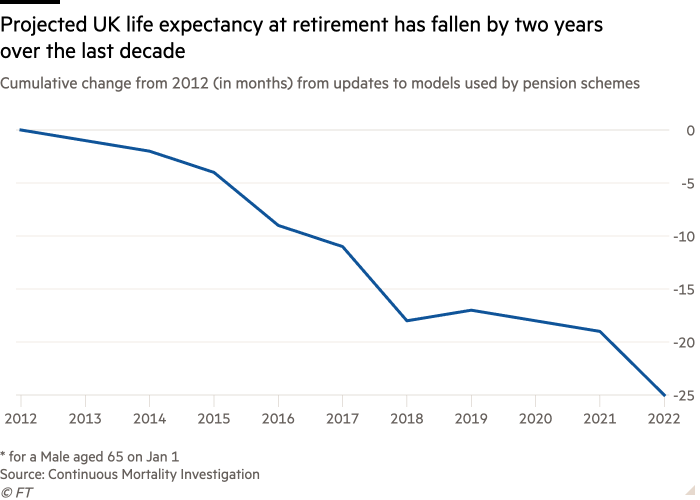Up to £30bn could be wiped from UK corporate pension scheme liabilities owing to one of the biggest falls in life expectancy in a decade, according to industry experts.
The latest modelling by actuaries saw life expectancy assumptions at retirement age fall 1.9 per cent, or six months, compared with the previous year’s model.
Industry analysts believe the forecasts could slash billions from the total liabilities of private sector defined benefit pension schemes, which stood at £1.28tn at the end of September 2022, according to the Office for National Statistics.
“We expect the typical impact of a scheme changing its longevity assumptions [from the 2021 model to 2022 model] to be a reduction in liabilities of around 2 per cent” — as high as £30bn, said Tim Gordon, partner with Aon, the actuarial consultancy.
About 10mn people in the UK belong to private sector defined benefit, or final salary schemes. These pay a guaranteed pension for as long as members and a surviving spouse live and use life expectancy models to help calculate the cost of meeting liabilities that can run decades into the future.

“For a typical defined benefit pension scheme, this is likely to be one of the largest year-on-year falls in life expectancy assumptions at retirement age in the last decade,” said Chris Tavener, partner at LCP, the actuarial consultants.
“Looking at the previous four versions of the model, the average change in life expectancies at age 65 from version to version was a few weeks, although some might have anticipated some of this fall already,” he added.

“The degree to which individual schemes will be affected will be influenced by a lot of scheme-specific factors, ranging from how and when they determine their funding assumptions to the amount of longevity risk they have already hedged,” said Stephen Caine, director of retirement with Willis Towers Watson, one of the largest pension consultancies in the UK.
The Continuous Mortality Investigation (CMI), supported by the Institute and Faculty of Actuaries, revises the tables annually to take into account the latest death trends. They are based on national population trends and are widely used by pension schemes and insurers to price products such as pensions, annuities and life cover.
In 2017-18, the CMI revised down life expectancy projections by about 7 months, the largest fall since the tables were established in 2009.
According to the investigation, the latest drop was owing to high death rates in England and Wales in the second half of 2022.
“While deaths in 2020 and 2021 were clearly abnormally high due to the significant numbers of deaths seen during the first two Covid-19 waves, deaths in 2022 were persistently higher than pre-pandemic expectations through much of the year,” said Jonathan Hughes, chair of the CMI.
“The CMI’s view is that these persistently higher than expected deaths may continue, as the underlying drivers appear likely to remain soon.”


Comments are closed, but trackbacks and pingbacks are open.